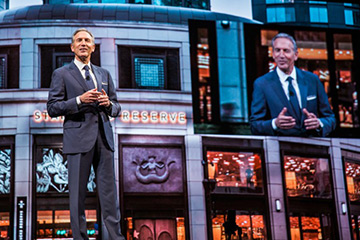Looking at Leadership: ‘A place where all people feel welcomed’
By Dr. Jalin B. Johnson

Outgoing Starbucks Executive Chairman Howard Schultz at the 2018 Shareholders meeting. Photo courtesy of Starbucks.
“I remember when a nickel would get you a cup of coffee and a good conversation.”
These are familiar words and yet they represent a reality that has long since passed us by. Today, a $4 cup of coffee is readily available at your local drive-thru cafe and may, in part, go towards much needed health insurance for a part-time barista.
Shortly before 7 a.m. on Tuesday May 29, 2018, I received “an open letter from Howard Schultz, ”who through the end of June is the executive chairman at Starbucks, a place I have frequented for several years.
In this letter, Schultz shared with millions of Starbucks’ external stakeholders, his inspiration and vision for the coffee house we now know today to be an internationally regarded fan favorite and one that is competitive in major markets around the globe.
He also discussed his ‘disappointment’ in a recent incident at a Starbucks Philadelphia location.
On April 12, 2018, Holly Hylton, manager of the Rittenhouse Square Starbucks, called the police on two 23-year-old entrepreneurs, Donte Robinson and Rashon Nelson, as they waited at a table before the start of a business meeting. Robinson and Nelson were soon arrested while waiting for their business associate. The incident was caught on camera by patrons at the location. Hylton was fired shortly thereafter.
Schultz’s early morning letter conveyed the steps that he and the other members of Starbucks’ leadership had taken after this incident and those that they continue to take in an effort to ensure that their locations are known as “a place where all people feel welcomed.”
On the afternoon of May 29, 2018, Starbucks chose to close its doors to begin “racial bias training,” with a desire to “set the foundation for a longer-term Starbucks anti-bias, diversity, equity, and inclusion effort,” according to a Starbucks press release.
It is important to note that Starbucks is not the first organization to institute similar training (proactively or reactively). This also comes amidst criticism from some who say that in firing the Rittenhouse Square manager, leadership acted hastily. It is however evident that examples of character and collective wisdom guided executives and stakeholders at Starbucks to go beyond simply disseminating a “vaguely worded” apology.
Proponents of Starbucks’ efforts have pointed out that their swift action separated them from Facebook, Uber and United Airlines, who recently suffered through PR nightmares due to their own actions, or inaction, while in the midst of a crisis.
Starbucks’ efforts to go “beyond the apology” began with a call to action and a request for guidance.
As leaders of people, organizations and communities, we have a responsibility to acknowledge when we don’t have all of the answers. Lying when we lack knowledge or “flying off the cuff” are not admirable behaviors, they are ignorant. We can learn from those who have walked the roads before us and seek input from those who are advocates for the voiceless.
Starbucks CEO Kevin Johnson began by apologizing to Robinson and Nelson. He then offered condemnation of the incident and chose to take ownership of what took place in Philadelphia. Top down-leadership sets an example, and for better or worse, subordinates will, more often than not, follow your lead.
Johnson soon asked for dialogue with Robinson and Nelson, requesting their insight. He did so, choosing not to offer excuses. He determined it meaningful to learn and grow and to not repeat a failure.
Members of the Starbucks leadership team, including Schultz, Johnson and Rosalind Brewer, chief operating officer and group president for Starbucks, sought guidance, forming an advisory committee for the Racial-Bias Training. Brewer shared with CNBC, ahead of the May training, “let us be the example of what diversity looks like…we have the ability to start a national conversation.”
Members of the Advisory Committee (Starbucks newsroom, 2018) included:
- Bryan Stevenson, founder and executive director of the Equal Justice Initiative;
- Sherrilyn Ifill, president and director-counsel of the NAACP Legal Defense and Education Fund
- Heather McGhee, president of Demos
- FormerU.S. Attorney General Eric Holder will serve as a key external advisor on the long-term diversity and equity efforts.
- Starbucks will also consult with a diverse array of organizations and civil rights experts, including The Anti-Defamation League, The Leadership Conference on Civil and Human Rights, UnidosUS, Muslim Advocates, and representatives of LGBTQ groups, religious groups, people with disabilities, and others.
While the effects of the May 2018 training may take time to materialize, the impact that the actions of those in leadership positions at Starbucks will have, should tell a story within the organization and infuse a larger narrative for years to come.
Starbucks’ leadership hopes to be an example in a climate where other companies are being challenged to be aware and to do more to develop this narrative of awareness and sensitivity within their organizational culture.
In recent months, companies including Airbnb, Waffle House, Nordstrom Rack, Pennsylvania’s Grandview Golf Club and LA Fitness have faced similar internal dialogue.
Academic institutions including Yale, Colorado State University and the University of Florida are re-examining the way belonging and otherness are addressed on their campuses.
Powerhouses Disney, ABC and Pixar have had to reconcile with how to model leadership astuteness, after canceling Rosanne and evaluating the employment of John Lasseter.
Each of these organizations are faced with a leadership choice; ignore when implicit bias, discrimination or questionable behavior has taken root and led to scandal or accept failures and try to be better moving forward.
Consider how your preferred coffee shop or other local businesses that you frequent fair at making people feel welcomed. The next time you’re sharing a cup of coffee and a good conversation, continue the discussion as you’re “Looking at Leadership.”
 Jalin B. Johnson, Ed.D., is an associate professor in the School of Business and Professional Studies at Brandman University, focusing on business and organizational leadership. She is a regular contributor on issues of leadership and current events.
Jalin B. Johnson, Ed.D., is an associate professor in the School of Business and Professional Studies at Brandman University, focusing on business and organizational leadership. She is a regular contributor on issues of leadership and current events.
